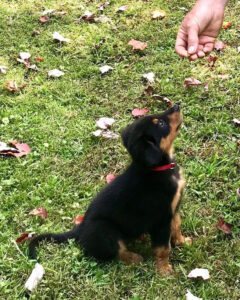Imagine how frustrating it would be for you if you felt you were unable to ask for things. This is a frustration that people with autism can sometimes feel. Fortunately, manding training is used to help individuals with autism learn to overcome this challenge. Manding is a way for the autistic to ask for things. On a site run by an Autism specialist, there’s a page that goes into greater detail about what manding is:
Manding can also be taught to dogs
A dog can learn to mand at any age, and some dogs do so naturally. A dog who learns to mand, particularly from a young age, is often a happier, more relaxed dog. For dogs, manding usually comes in the form of a voluntary sit (I’ve met a few dogs who mand from a standing position, and I think that’s OK, too). If the sit is preceded by a cue from the handler, that is not a mand. A proper mand is offered by the dog, not asked for by the handler. The mental process to sit voluntarily is different for a dog than if asked to do so. What makes manding so beneficial for a dog is knowing that he or she can ask for things in a way that is acceptable to humans.
How to teach manding to a litter of puppies?
You’ll need a training clicker and some pea-sized hotdog pieces. Place the puppies in an ex-pen or similar arrangement where they can see you and you can reach them. Hold the clicker and treats behind your back. Each time a puppy puts his or her butt on the ground, click and treat. Don’t say sit, don’t say anything. Continue this for 3 or 4 minutes. You can conduct manding training multiple times per day. Within a few days, most if not all pups in the litter will be manding. I start manding training with a litter at around day 20, and continue it daily until the puppies go home.

Looking behind the curtain
By way of explanation, the process of training a dog to mand involves a clicker as a conditioned reinforcer (Pryor, 2019) and treats as primary reinforcement. With a puppy, manding training is valuable on at least two levels. First, the young puppy learns that to sit patiently in front of a human being is a rewarding experience. Second, the pup learns that he or she can offer behaviors and receive rewards. A puppy armed with this knowledge will use it throughout its life, offering both new and existing behaviors to please its handler.
References
Return to the CHEW Protocol main page

This work (A Canine Health Enrichment and Whelping Protocol, by the Old-fashioned Black & Tan English Shepherd Association) is free of known copyright restrictions.

